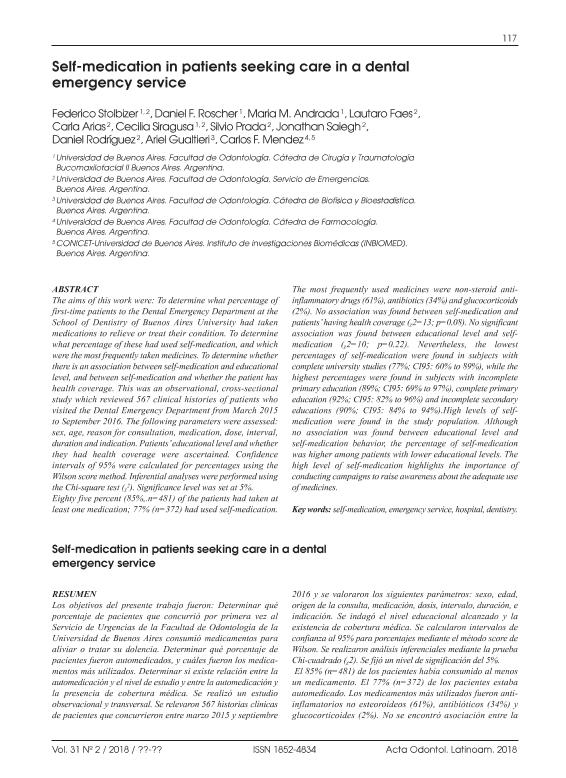Artículo
Self-medication in patients seeking care in a dental emergency service
Stolbizer, Federico; Roscher, Daniel F.; Andrada, Maria M.; Faes, Lautaro; Arias, Carla; Siragusa, Cecilia; Prada, Silvio; Saiegh, Jonathan; Rodriguez, Daniel; Gualtieri, Ariel Félix; Mendez, Carlos Fernando

Fecha de publicación:
08/2018
Editorial:
ImageGraf
Revista:
Acta Odontológica Latinoamericana
ISSN:
0326-4815
e-ISSN:
1852-4834
Idioma:
Inglés
Tipo de recurso:
Artículo publicado
Clasificación temática:
Resumen
The aims of this work were: To determine what percentage of firsttime patients to the Dental Emergency Department at the School of Dentistry of Buenos Aires University had taken medications to relieve or treat their condition. To determine what percentage of these had used selfmedication, and which were the most frequently taken medicines. To determine whether there is an association between selfmedication and educational level, and between selfmedication and whether the patient has health coverage. This was an observational, crosssectional study which reviewed 567 clinical histories of patients who visited the Dental Emergency Department from March 2015 to September 2016. The following parameters were assessed: sex, age, reason for consultation, medication, dose, interval, duration and indication. Patients' educational level and whether they had health coverage were ascertained. Confidence intervals of 95% were calculated for percentages using the Wilson score method. Inferential analyses were performed using the Chisquare test (ᵪ2). Significance level was set at 5%. Eighty five percent (85%,.n=481) of the patients had taken at least one medication; 77% (n=372) had used selfmedication. The most frequently used medicines were nonsteroid antiinflammatory drugs (61%), antibiotics (34%) and glucocorticoids (2%). No association was found between selfmedication and patients' having health coverage (ᵪ2=13; p=0.08). No significant association was found between educational level and selfmedication (ᵪ2=10; p=0.22). Nevertheless, the lowest percentages of selfmedication were found in subjects with complete university studies (77%; CI95: 60% to 89%), while the highest percentages were found in subjects with incomplete primary education (89%; CI95: 69% to 97%), complete primary education (92%; CI95: 82% to 96%) and incomplete secondary educations (90%; CI95: 84% to 94%).High levels of selfmedication were found in the study population. Although no association was found between educational level and selfmedication behavior, the percentage of selfmedication was higher among patients with lower educational levels. The high level of selfmedication highlights the importance of conducting campaigns to raise awareness about the adequate use of medicines.
Palabras clave:
SELF-MEDICATION
,
DENTAL CARE
,
EMERGENCY SERVICE
Archivos asociados
Licencia
Identificadores
Colecciones
Articulos(BIOMED)
Articulos de INSTITUTO DE INVESTIGACIONES BIOMEDICAS
Articulos de INSTITUTO DE INVESTIGACIONES BIOMEDICAS
Articulos(INBIOMED)
Articulos de INSTITUTO DE INVESTIGACIONES BIOMEDICAS
Articulos de INSTITUTO DE INVESTIGACIONES BIOMEDICAS
Citación
Stolbizer, Federico; Roscher, Daniel F.; Andrada, Maria M.; Faes, Lautaro; Arias, Carla; et al.; Self-medication in patients seeking care in a dental emergency service; ImageGraf; Acta Odontológica Latinoamericana; 31; 2; 8-2018; 117-121
Compartir



